Savannah Clam Company and a recipe for Steamed Littleneck Clams with White Wine Sauce
The seasons pose different problems for clamming. In the summer months, water temperatures reach 85 degrees. These high temperatures take a toll on the clams. We saw quite a few that were dead the day we were with John. The transition out of these hot waters into the coolers, which are 40 to 45 degrees, can shock the clams and some will be lost to the extreme temperature change. The shelf life on clams in the summer is one week.
In the winter months, the water temperatures run between the high 40s to low 50s. The mollusks thrive in these temperatures and the transition to the storage cooler is much easier and fewer clams are lost. He can keep winter clams up to two weeks.
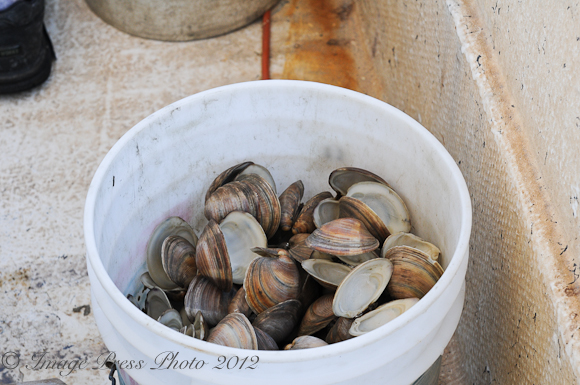
Some of the clams that did not survive
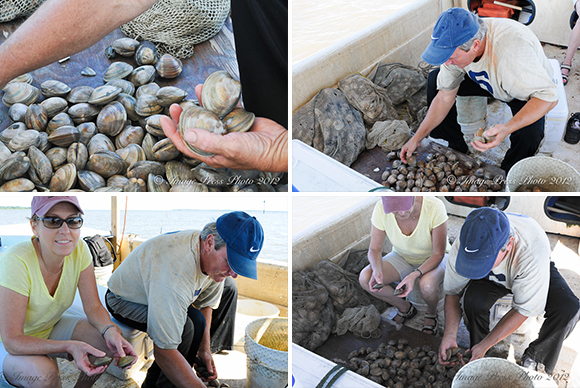
Sorting and counting clams is tedious work
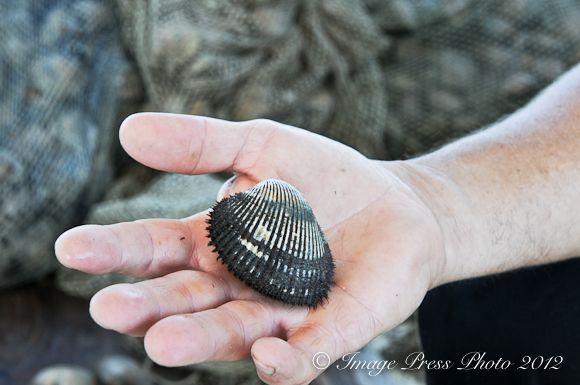
Blood Arc – a delicacy that is popular in Asian restaurants
John has been working on the development of a machine that would assist in the tedious process of raking the clams from the sandy bottom of the rivers before they go into the final phase prior to harvest. While he has had one prototype, he continues with its development and hopes to have it perfected in the near future.
The most amusing thing we learned while clamming is that John’s wife does not eat seafood and he doesn’t care much for clams. “I’ll occasionally eat 6 or 12 of them with balsamic vinegar and then I am good for a month.” Thankfully, his brother enjoys them and will eat 100 or so at one seating. 🙂
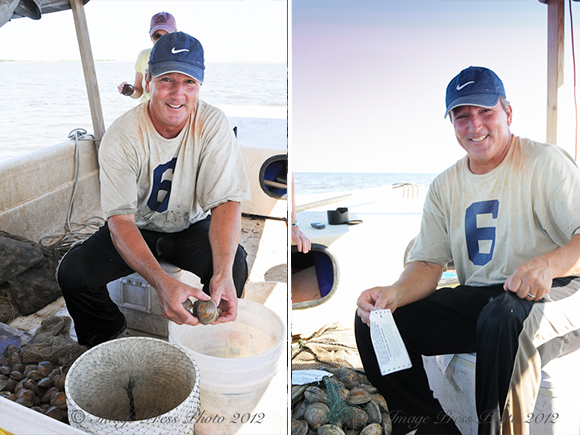
John seems really happy when on the river
It is peaceful on the river and while clamming is physically challenging and sometimes dangerous (John has had a few stingray barbs over the years), I can see why this man enjoys his work. He laughs a lot about life in general and always seems to have a smile.
“I got tired of the corporate world and the travel became too hard. I could always go back to a cubicle job and yeah, I’d be better off financially. You are only here for a split second, so you better enjoy what you do. Look at today (motioning to the blue skies and warm breezes). That’s what I love about this.”
We had to agree. We have heard this from so many corporate transplants that have given up the security of a company job to start their own business in farming. Manakintowne Specialty Growers, Kimberly’s Crabs, Carolina Bison, Singer Farm Naturals, River Road Farms, and Tennessee Truffles are just a few of the people we have worked with that made the transition to farming. They were at one time either doctors, lawyers, or business executives. It is all about the quality of life.
As Richard Bach said, “The river delights to lift us free, if only we dare to let go”.
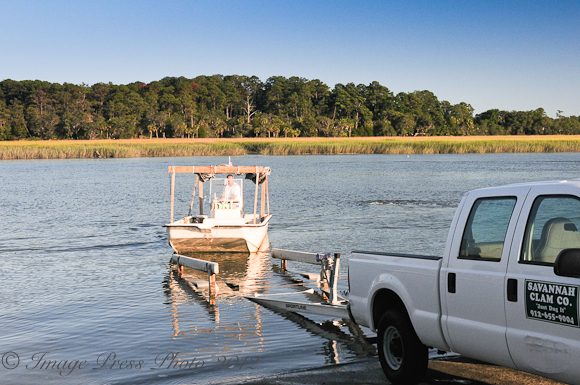
Bringing in the boat at the end of the day
Thank you so much to John for allowing us to take a glimpse into his life as a clammer. We enjoyed the time spent getting to know him, learning more about clamming, and experiencing the beauty of the river in Savannah.
John sent us home with a bag of gorgeous clams and recipes from an event that he participated in in March 2009, Romancing the Clam. Roger is a huge fan of these little guys, so he was happy as a clam. Sorry…just had to say that. 😉
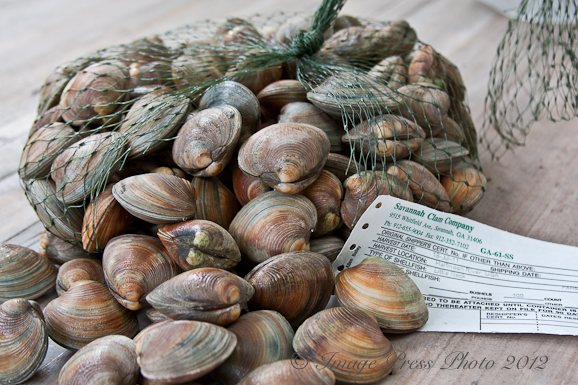
Clams fresh from the rivers of Savannah
This recipe is from Chef Joe Elliott in Providence, Rhode Island. It is a simple preparation, but the broth is very flavorful and perfect with crusty French bread to sop it up from the bowl. When shellfish is this fresh, it is best to enjoy the flavors of the clams and not overwhelm them with too many other ingredients.
Enjoy!
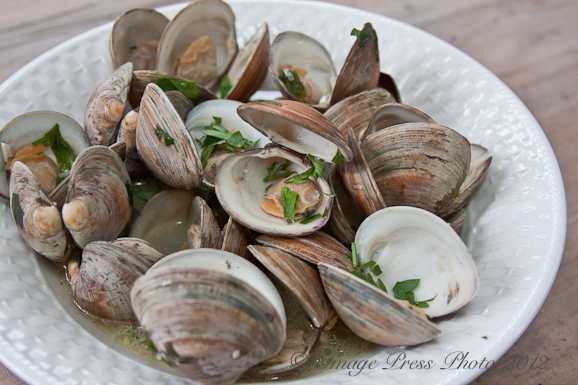
Roger loved these!

Steamed Littleneck Clams with White Wine Sauce
This recipe from Chef Joe Elliott was originally called Northern Neck Clams and was one of the recipes prepared at Romancing the Clam in Savannah, March 2009. Chef Elliott used clams from the Northern Neck region of the Western Shore of Virginia. I used fresh Littleneck Clams from Savannah Clam Company in this recipe.
Ingredients:
25 small clams in shell, scrubbed
2 tablespoons Extra-virgin olive oil
6 cloves garlic, minced
1 cup white wine (I used a Sauvignon Blanc)
2 tablespoons unsalted butter
1/2 cup chopped fresh Italian parsley
1/2 cup julienne Smithfield ham
Directions:
1. Wash and scrub clams to remove any dirt or sand. In a large pot, heat olive oil over medium heat. Add garlic; saute for 1 minute or until tender. Pour in the white wine and boil until wine has reduced to half its original volume.
2. Add clams, cover, and steam until clams start to open. Add butter and ham, cover, and cook until most or all of the clams have opened. The whole process should take between 10 to 15 minutes. Discard any that do not open.
3. Transfer clams and sauce to large bowls. Sprinkle with parsley. Serve immediately.
Chef Joe Elliott
Providence Westin
Providence, Rhode Island
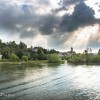
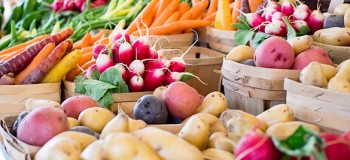





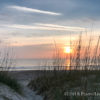

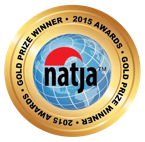






I LOVE the first photo – American Gothic the clamming edition,, but much younger 😉 I adore little necks , and not only do I envy you for taking part in this experience, I envy you because you ate that dish of clams. The recipe sounds amazing, I think I need to clamming this summer 🙂
Hi Lisa,
I was hoping that photo would get recognized properly. Taking that shot was an opportunity too hard to resist. 😉
We had an incredible experience clamming with John. There is nothing quite as local or as fresh as pulling clams out of the river and taking them home for dinner! Mr. B was in heaven.
Gwen
These look so pretty! When I was a kid we’d dig clams on the flats before having a lobster & clambake on the beach in Maine. The kids loved it but I remember my mother saying how much work it was getting it all organized.
I bet you had a great time.
Clamming is sooo much fun! I’m glad you got to play around and give it a try 😀 Love the recipe as well.
Great story and very well-told. Loved the joke at the end. 🙂
I had a great opportunity going Clamming with John Pelli, please check out our video From Sea to Serving Check out this video on YouTube:
http://www.youtube.com/watch?v=UTYa31eNQ68&feature=youtube_gdata_player
We’re big into clamming when we’re on the Cape. This post made me so happy… reminded me that there’s nothing like fresh clams in a simple white wine sauce.
You do look like you were a born clammer! I love this very well written piece and I love the pictures. I adore seafood and clams in particular and this was truly a fascinating read. I admire people who can quit that hum drum office life and turn to the earth or the sea for their livelihood. Admirable, indeed. I have seen oyster farms but never clam farms. Great write up, Gwen…and it looks like it was a fun day. And the recipe is great – almost identical to the way we prepare mussels. And clams when we buy them. Perfect.
What an opportunity! I want to go clamming now…and I certainly want to make this recipe. I love simple seafood meals like this. Thank you for sharing…and thank you for all the support. It means more to me than you know. Hugs and love from Austin.
A perfect day! good for john for follwing his love for the river, great piece and the love the white wine sauce!
I guess the good thing about not eating the clams you harvest is there are more to sell.But me I’d eat myself out of business. GREG
I loved reading about John. How interesting that he’s the only clammer in Savannah and wonderful to know that University of Georgia offers that scholarship. I got a kick out of reading tha his wife doesn’t like seafood and he’s not the biggest fan of clams…more for his brother;) A loaf of crispy bread and some nice white wine with your clams is perfection.
How interesting! I love to hear about folks taking a risk by following their passion and being successful at it and turning their career around. Fantastic write up and supporting images, Gwen and Mr. B. Love the image of the clam seeds! 🙂
Isn’t clamming so interesting? I was lucky enough to get an education on it when I was in the Chesapeak Bay area to visit with some guys from J&W Seafood (crabville.com) and learned so much! Plus all their seafood tastes great and is available to buy online!